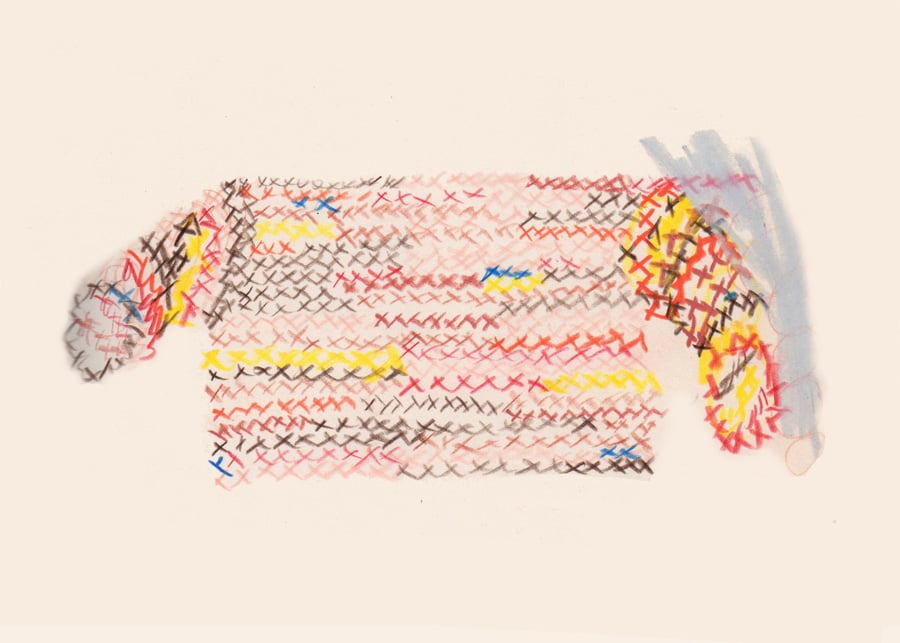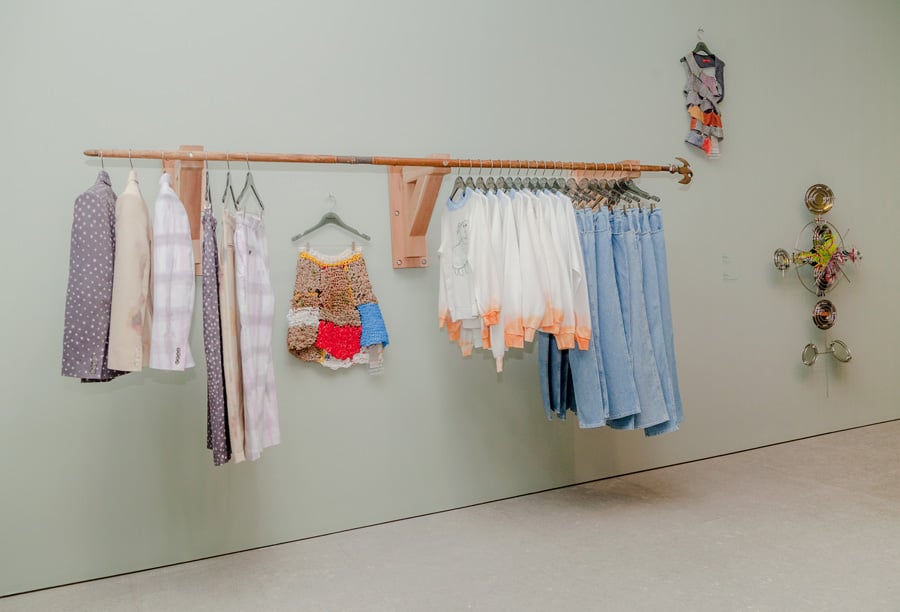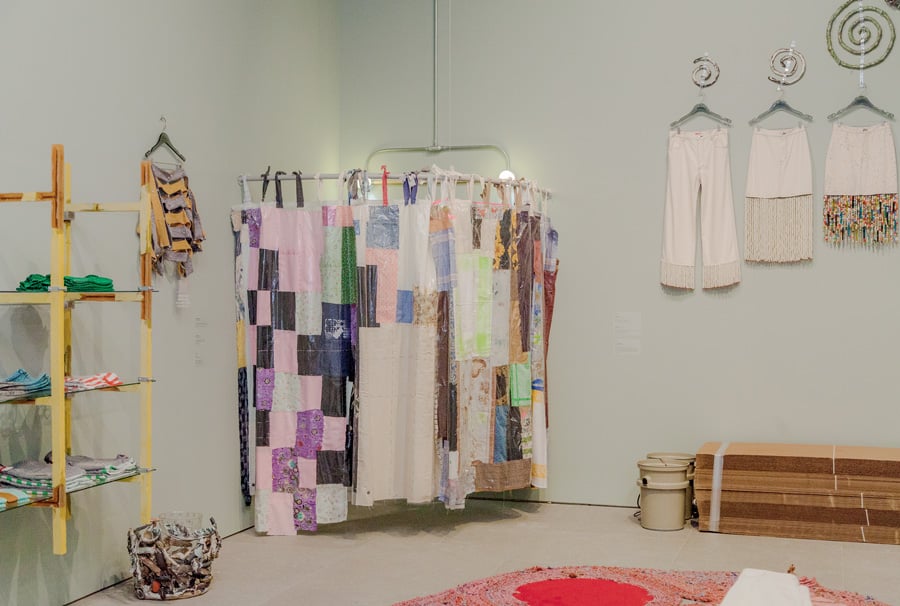
August 17, 2018
Shop Talk: Making Sense of Eckhaus Latta at the Whitney
The museum’s genre-defying show—its first fashion-themed exhibition in 21 years— is as much about politics as it is about clothing.

There is something radical about going into a major American arts institution and taking your clothes off. There is something equally radical about then trying on a one-of-a-kind sweater made from plastic bags and—if your heart so desires, and your wallet so allows—buying it.
These are some of the conceits underpinning an intriguing new show at the Whitney Museum of American Art, a high-low riot of fashion and art devoted to the work of cult fashion label Eckhaus Latta.
Laypeople can be forgiven if they have never heard of Eckhaus Latta. The Los Angeles-and-New York brand, founded in 2011 by RISD classmates Mike Eckhaus and Zoe Latta, quickly developed a reputation for its ’90s-inflected, deconstructed garments and provocative politics: gender fluid collections, runway shows reflecting real bodies, an ad campaign featuring copulating couples. Ultimately, the designers seek to free their clothes from “branding or marketing mechanisms that make people feel small,” as Eckhaus told Dazed magazine in 2016.
Eckhaus Latta: Possessed marks the duo’s first solo exhibition, though they’ve been a part of group shows at MoMA PS1 and elsewhere. It also marks the first time the Whitney has mounted a fashion show in 21 years, and perhaps duly so: 1997’s The Warhol Look: Glamour Style Fashion, a sartorial investigation into the life of the famed pop artist, was dubbed, in the words of New York Times critic Holland Cotter, “tame” and emblematic of art’s “uncritical alliance with the fashion industry.”
In spite of such sharp criticisms, the museum fashion show has become a familiar—even perfunctory—staple within the art world, with the Met’s annual Costume Institute extravaganza leading the charge. MoMA even jumped back into the fray last fall after a 70-year hiatus.
Because of this, the show’s organizers, Christopher Y. Lew and Lauri London Freedman, wanted to intentionally avoid the usual curatorial template. “When you have a traditional fashion exhibition you are seeing clothes on mannequins and you can’t touch it,” says Lew, also a curator of the 2017 Whitney Biennial. “We didn’t want to treat the clothing as an inaccessible art object. It’s intended to be worn.”

Unlike its fashionable forebears, Possessed exists within a blurry confluence of installation art and social practice. From a dark antechamber filled with illuminated images of models kitted out in Eckhaus Latta attire, visitors step into a fully functioning clothing boutique. The gallery has all of the trappings of a typical retail outlet: a point-of-sales area, shelves and racks, and a dressing room, with limited-edition pieces by Eckhaus Latta displayed carefully throughout.
But the merch is not the sole draw here. Eckhaus and Latta invited artist friends, family, and collaborators to design both the boutique layout (by designer Emma T. Price) and the display elements, ranging from a ceramic sunglasses display to jewelry cases designed by Latta’s father. Gallerygoers are encouraged to bring the clothing to a corner dressing area (with a bespoke patchwork curtain created by Susan Cianciolo) and try them on. A third room, formally the show’s weakest, features one-way mirrors and live security feeds from the adjoining gallery, all intending to critique, according to wall text, “how voyeurism has become an increasingly normalized part of the consumer experience.”

In a sense, Possessed can be viewed as an extension of Lew’s research for the 2017 Whitney Biennial, during which he first encountered Eckhaus Latta. Though the designers were not included in that show, “I was always interested in working with cultural producers who are not necessarily artists,” Lew explains. The work of Biennial participants Jessi Reaves, Torey Thornton, and Cianciolo also makes an appearance in Possessed and is in neat dialog with Eckhaus Latta’s garments through a mutual reliance on DIY aesthetics, repurposed materials, and political messaging. And like the Biennial, Possessed is at its most illuminating when viewed as a social barometer, not, as critique of fashion and consumer culture as the show’s setup might suggest.
But where the 2017 Biennial–fresh off the heels of the country’s most divisive election in memory–tackled themes of violence, equality, and anger, Possessed projects feelings of political ennui and fatigue. This is particularly acute in the clothing Eckhaus Latta’s designed for the show. One style of pants, folded neatly on top of a display table made from discarded milk crates, reads enigmatically, “Most places come undone”; its matching sweater says, “Trying to organize the fantasy.” A stenciled t-shirt boasts weakly, “I was on the American flag’s website.”
This feeling also pervades the artist-made objects throughout the boutique. Take a clothing rack by Jeffrey Joyal made from a horizontal marching band flagpole, its eagle tipped sideways like a defeated medieval pike. One particularly ingenious piece is a rug by Sophie Stone, which has a slipper embedded in it, as if its maker absentmindedly forgot what he or she was doing.
Part of the exhibition’s appeal, according to Freedman, the co-curator and the museum’s head of product development, was to explore “the power that the opportunity to take something home with you [from museums] can have.”
But that democratic spell is easily broken in Possessed as soon as one flips over a price tag. A pair of socks is priced at $75. T-shirts start at $60. The handmade sweater made of plastic bags? $7,200. (Museum members get a 10 percent discount.) This doesn’t seem to be lost on another pair of Eckhaus Latta socks monogrammed with the query, “Who’s paying for all of this?”
It’s a good question. Is this a futile game of dress up for the average museumgoer, or will they buy into the show’s conceit? Some already have: one t-shirt sold out within two days, a sales associate said. But more visitors will be far more likely to traverse the ground floor to the opposite corner, to the Whitney’s actual museum store, and buy a postcard.
Eckhaus Latta: Possessed is on view at the Whitney American Museum of Art through October 8, 2018.
You might also like, “For the Design of the Met’s Costume Institute Show, Diller Scofidio + Renfro Channel the Sublime—and Mies.”
Recent Viewpoints
Viewpoints
Navigating the Path to Net Zero













